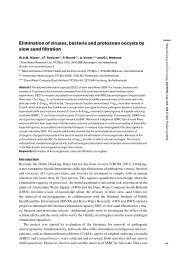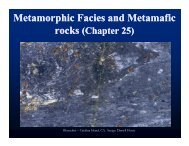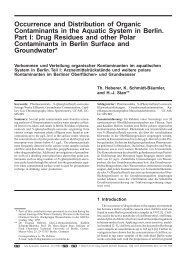Igneous Rocks Genetic Classification of Igneous Rocks
Igneous Rocks Genetic Classification of Igneous Rocks
Igneous Rocks Genetic Classification of Igneous Rocks
You also want an ePaper? Increase the reach of your titles
YUMPU automatically turns print PDFs into web optimized ePapers that Google loves.
<strong>Igneous</strong> <strong>Rocks</strong><br />
Fig. 5.1<br />
<strong>Genetic</strong> <strong>Classification</strong> <strong>of</strong><br />
<strong>Igneous</strong> <strong>Rocks</strong><br />
• Intrusive: crystallized from<br />
slowly cooling magma<br />
intruded within the Earth’s<br />
crust; e.g. granite, gabbro<br />
1
Fig. 5.2<br />
<strong>Genetic</strong> <strong>Classification</strong> <strong>of</strong><br />
<strong>Igneous</strong> <strong>Rocks</strong><br />
• Extrusive: crystallized from<br />
rapidly cooling magma extruded<br />
on the surface <strong>of</strong> the Earth as<br />
lava or erupted as pyroclastic<br />
material.<br />
Fig. 5.3<br />
2
Extrusive <strong>Igneous</strong> <strong>Rocks</strong><br />
Include:<br />
• rocks formed from the cooling <strong>of</strong><br />
lavas<br />
• rocks formed by the cooling <strong>of</strong><br />
pyroclastic material, i.e.<br />
fragmented pieces <strong>of</strong> magma<br />
and material erupted into the air<br />
Table. 5.1<br />
Composition and <strong>Classification</strong><br />
<strong>of</strong> <strong>Igneous</strong> <strong>Rocks</strong><br />
• Chemistry: e.g. % SiO 2<br />
• Mineralogy: e.g.<br />
–Felsic<br />
–Intermediate<br />
–Mafic<br />
–Ultramafic<br />
3
Fig. 4.4<br />
How do magmas form<br />
When rocks melt (or partially melt).<br />
Partial Melting<br />
Occurs when some <strong>of</strong> the<br />
minerals forming a rock melt<br />
at lower temperatures than<br />
other minerals within the<br />
same rock<br />
4
Table 4-3<br />
Magma pools in<br />
magma chamber<br />
Magma rises<br />
Less dense magma<br />
The<br />
Formation <strong>of</strong><br />
Magma<br />
Chambers<br />
Partial melting<br />
Magma Differentiation<br />
The process by which rocks <strong>of</strong><br />
various compositions can<br />
arise from a uniform parent<br />
magma<br />
5
Magma Differentiation<br />
Occurs because different minerals<br />
crystallize at different temperatures<br />
(i.e., the opposite <strong>of</strong> partial melting)<br />
Fractional Crystallization<br />
The process by which<br />
crystals forming in a<br />
cooling magma are<br />
segregated from the<br />
remaining liquid<br />
Bowen’s s Reaction Series<br />
Experimental sequence <strong>of</strong><br />
crystallization <strong>of</strong> minerals<br />
from a gradually cooling<br />
mafic (basaltic) magma<br />
6
Bowen’s s Reaction Series<br />
Fig. 4.5<br />
Evidence <strong>of</strong> Fractional<br />
Crystallization in the Palisades Sill<br />
Fig. 4.5<br />
Evidence <strong>of</strong> Fractional<br />
Crystallization in the Palisades Sill<br />
Fig. 4.5<br />
7
Can fractional crystallization <strong>of</strong> a<br />
primitive basaltic (mafic) magma<br />
generate a granitic (felsic )<br />
magma<br />
Yes, but not in the<br />
amounts present in the<br />
continental crust!<br />
Modern Ideas <strong>of</strong> Magmatic<br />
Differentiation<br />
1. Partial melting<br />
creates magma <strong>of</strong><br />
specific composition<br />
2. Cooling causes<br />
minerals to form and<br />
settle<br />
Fig. 4.6<br />
Modern Ideas <strong>of</strong> Magmatic<br />
Differentiation<br />
3. Basaltic magma<br />
breaks through,<br />
causing turbulence<br />
4. Crystals are mixed<br />
and deposited on<br />
chamber walls<br />
5. Mixing <strong>of</strong> two<br />
magmas produces an<br />
andesitic magma<br />
Fig. 4.6<br />
8
Partial Melting<br />
and the Origin <strong>of</strong> Magmas<br />
Partial melting <strong>of</strong> upper<br />
mantle: e.g. at divergent<br />
spreading centers<br />
Partial melting <strong>of</strong> sedimentary<br />
rocks and mafic lithosphere:<br />
e.g. in subduction zones<br />
Partial melting <strong>of</strong> continental<br />
crustal rocks<br />
Mafic<br />
Magmas<br />
Intermediate<br />
Magmas<br />
Felsic<br />
Magmas<br />
Plutons<br />
Large igneous bodies<br />
formed at depth in the<br />
Earth’s crust<br />
Types <strong>of</strong> Plutons<br />
• Batholith: Massive, discordant intrusive<br />
body covering at least 100 km 2<br />
• Stock: Massive, discordant intrusive body<br />
covering less than 100 km 2<br />
• Dike: Tabular, discordant intrusive body<br />
• Sill: Tabular, concordant intrusive body<br />
9
Fig. 4.9<br />
Sill<br />
Fig. 4.9<br />
Fig. 4.9<br />
10
Dike<br />
Fig. 4.9<br />
Granite Pegmatite<br />
Fig. 4.10<br />
Where do most magmas form<br />
• Divergent Plate Margins<br />
• Convergent Plate Margins<br />
• Mantle Plumes/Hot Spots<br />
11
Plate Divergence<br />
e.g. Mid-Atlantic Ridge<br />
Fig. 4.11<br />
Island Arc<br />
Plate Subduction<br />
e.g. Java, Indonesia<br />
Fig. 4.11<br />
Continental<br />
Plate Subduction<br />
e.g. Mt Ranier<br />
Fig. 4.11<br />
12
Hot Spot<br />
Volcanism<br />
e.g., Hawaii<br />
Yellowstone<br />
Fig. 4.11<br />
Idealized Section<br />
<strong>of</strong> an Ophiolite<br />
Suite<br />
<br />
Fig. 4.12<br />
Generation <strong>of</strong> Magmas at<br />
Divergent Plate Margins<br />
• Partially melted asthenosphere<br />
(Peridotite) rises at spreading<br />
centers, causing decompression<br />
melting <strong>of</strong> up to 15% <strong>of</strong> the rock<br />
to form mafic magma.<br />
13
Fig. 4.13<br />
Fig. 4.13<br />
Generation <strong>of</strong> Magmas at<br />
Convergent Plate Margins<br />
• Subduction drags oceanic<br />
lithosphere (including a veneer<br />
<strong>of</strong> “wet” sediments) beneath the<br />
adjacent plate<br />
14
Generation <strong>of</strong> Magmas at<br />
Convergent Plate Margins<br />
• The release <strong>of</strong> volatiles lowers the<br />
melting point <strong>of</strong> the adjacent<br />
mantle, causing fluid-induced<br />
melting to form a mafic magma,<br />
which becomes more intermediate<br />
in composition as it rises through<br />
the overlying crust<br />
Fig. 4.14<br />
x<br />
Fig. 4.14<br />
15


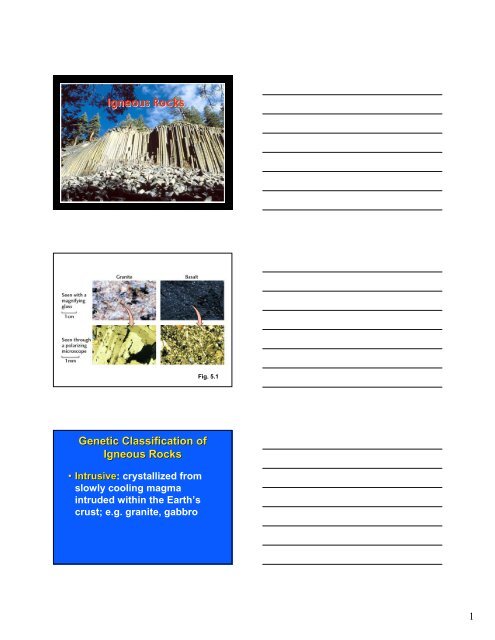


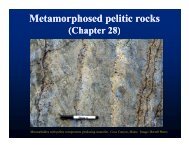



![21-IntroductionMetamorphism [Compatibility Mode].pdf](https://img.yumpu.com/32952021/1/190x146/21-introductionmetamorphism-compatibility-modepdf.jpg?quality=85)
